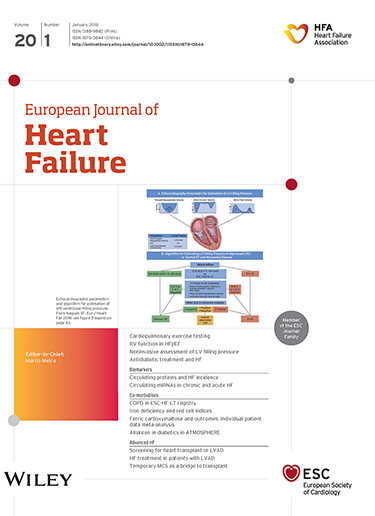Exercise haemodynamics in pulmonary hypertension - a prospective pressure-volume loop study on right ventricular adaptation and prognosis.
IF 10.8
1区 医学
Q1 CARDIAC & CARDIOVASCULAR SYSTEMS
引用次数: 0
Abstract
AIMS The haemodynamic response to exercise is prognostic in pulmonary hypertension (PH). However, little is known about right ventricular (RV) adaptation in this context. We analysed the patterns and prognostic relevance of RV adaptation to exercise in PH. METHODS AND RESULTS We prospectively analysed 46 patients with PH and 19 disease controls with invasive exclusion of PH. All underwent three-dimensional echocardiography, pressure-volume catheterization, and right heart catheterization at rest and during stepwise exercise on a semi-supine ergometer. Patients with PH were classified as homeometric if they had increased RV end-systolic elastance and preserved RV-pulmonary arterial coupling (end-systolic/arterial elastance) during exercise (18 patients); otherwise, they were classified as heterometric (28 patients). The mean pulmonary arterial pressure/cardiac output (mPAP/CO) slope was similar in the homeometric and heterometric groups (8.8 [6.5-13.1] vs. 8.6 [4.8-18.8] mmHg·min/L), and lower in disease controls (2.1 [1.1-4.0] mmHg/L). Multivariable logistic regression identified systolic pulmonary arterial pressure change during exercise (ΔsPAP) (odds ratio [OR] 0.93, 95% confidence interval [CI] 0.87-0.99; p = 0.019) and peak exercise cardiac index (OR 0.42, 95% CI 0.18-0.97; p = 0.042) as key differentiators of homeometric/heterometric adaptation. Heterometric adaptation was significantly associated with clinical worsening and all-cause mortality (log-rank p = 0.0006 and p = 0.0246, respectively) and independently predicted clinical worsening (hazard ratio [HR] 6.52, 95% CI 2.16-19.63; p = 0.001); the HR for all-cause mortality was 6.96 (95% CI 0.87-55.66; p = 0.067). CONCLUSIONS Pulmonary hypertension can present with two RV patterns under stress: homeometric with increased contractile reserve and heterometric with poorer outcome. While the mPAP/CO slope does not differentiate the two, ΔsPAP and peak cardiac index offer potential for RV adaptation pattern identification and thus prognostication.肺动脉高压的运动血流动力学——一项关于右心室适应和预后的前瞻性压力-容量环研究。
目的:运动对血流动力学的反应是肺动脉高压(PH)的预后。然而,在这种情况下,对右心室(RV)的适应知之甚少。我们分析了PH患者RV适应运动的模式和预后相关性。方法和结果我们前瞻性地分析了46例PH患者和19例疾病对照者,并有创性地排除了PH。所有患者在休息时和在半仰卧测功仪上逐步运动时均进行了三维超声心动图、压力-容量导管置入和右心导管置入。如果PH患者在运动过程中右心室收缩末期弹性增加,右心室-肺动脉耦合(收缩末期/动脉弹性)保持不变,则将其归类为homeometric(18例);否则归类为异长(28例)。平均肺动脉压/心输出量(mPAP/CO)斜率在同源计量组和异源计量组相似(8.8[6.5-13.1]对8.6 [4.8-18.8]mmHg·min/L),疾病对照组较低(2.1 [1.1-4.0]mmHg/L)。多变量logistic回归确定运动期间肺动脉收缩压变化(ΔsPAP)(优势比[OR] 0.93, 95%可信区间[CI] 0.87-0.99;p = 0.019)和峰值运动心脏指数(OR 0.42, 95% CI 0.18-0.97;P = 0.042)作为同源/异源适应的关键区分因素。异量适应与临床恶化和全因死亡率显著相关(log-rank分别为p = 0.0006和p = 0.0246),并独立预测临床恶化(风险比[HR] 6.52, 95% CI 2.16-19.63;p = 0.001);全因死亡率HR为6.96 (95% CI 0.87-55.66;p = 0.067)。结论肺动脉高压在应激状态下可表现为收缩储备增加的同源型和预后较差的异速型两种RV模式。虽然mPAP/CO斜率不能区分两者,但ΔsPAP和峰值心脏指数提供了RV适应模式识别和预后的潜力。
本文章由计算机程序翻译,如有差异,请以英文原文为准。
求助全文
约1分钟内获得全文
求助全文
来源期刊

European Journal of Heart Failure
医学-心血管系统
CiteScore
27.30
自引率
11.50%
发文量
365
审稿时长
1 months
期刊介绍:
European Journal of Heart Failure is an international journal dedicated to advancing knowledge in the field of heart failure management. The journal publishes reviews and editorials aimed at improving understanding, prevention, investigation, and treatment of heart failure. It covers various disciplines such as molecular and cellular biology, pathology, physiology, electrophysiology, pharmacology, clinical sciences, social sciences, and population sciences. The journal welcomes submissions of manuscripts on basic, clinical, and population sciences, as well as original contributions on nursing, care of the elderly, primary care, health economics, and other related specialist fields. It is published monthly and has a readership that includes cardiologists, emergency room physicians, intensivists, internists, general physicians, cardiac nurses, diabetologists, epidemiologists, basic scientists focusing on cardiovascular research, and those working in rehabilitation. The journal is abstracted and indexed in various databases such as Academic Search, Embase, MEDLINE/PubMed, and Science Citation Index.
 求助内容:
求助内容: 应助结果提醒方式:
应助结果提醒方式:


